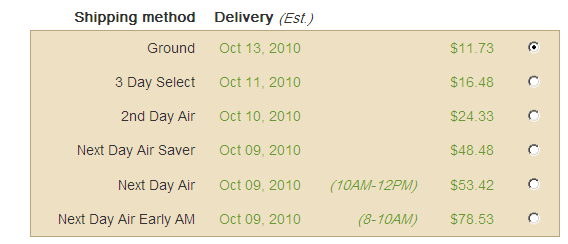Archive for October, 2010
What is a trust seal actually worth?
 I was asked the question this week of what trust seals I would recommend a website use? Trust seals would include services like Mcafee, Truste, the BBB, Verisign SSL, etc. Putting aside any potential real benefits in security, I think that these seals can help a business increase their conversion rate. However, I think the statistics touted by the seal providers themselves are greatly exaggerated, even to the point of them being statistically impossible. I’ve seen statistics like “over 70% increase in conversions”. While this may be theoretically possible, it’s just not plausible that the site seal somehow convinced double or more the amount of visitors to make a purchase, unless there were serious problems with the site before the seal was installed, or there wasn’t enough data for statistical significance.
I was asked the question this week of what trust seals I would recommend a website use? Trust seals would include services like Mcafee, Truste, the BBB, Verisign SSL, etc. Putting aside any potential real benefits in security, I think that these seals can help a business increase their conversion rate. However, I think the statistics touted by the seal providers themselves are greatly exaggerated, even to the point of them being statistically impossible. I’ve seen statistics like “over 70% increase in conversions”. While this may be theoretically possible, it’s just not plausible that the site seal somehow convinced double or more the amount of visitors to make a purchase, unless there were serious problems with the site before the seal was installed, or there wasn’t enough data for statistical significance.
So, the real question is, what makes these seals justifiable?
Realistically, if a site seal provides any increase in conversions, there is a point where the benefit surpasses the cost to obtain a site seal. But, where is that point?
My typical answer is that for a new website they will not provide a positive ROI until the business has a substantial amount of sales. Basically, don’t get one until you are already well established. Substantial is a very ambiguous answer, let’s look at what substantial sales actually mean.
Let’s say a site can benefit by a 5% increase in raw conversion by installing a trust seal, far below the 75% that some claim, but still high as far as I’m concerned. Let’s also say they are using a seal that costs $1000 per year, and are currently operating with a 20% profit margin.
Plugging this into an equation to calculate the sales required for a positive ROI:
(profit margin)(sales + increase in sales) = (cost of seal)
.20(1x + .05x) = $1000
.20(1.05x) = $1000
1.05x = $1000/.2
x = $1000/.2/1.05
Sales = $4761.90
This business would need an additional $4761.90 in sales in the next year, or $396.86 per month, to get a positive ROI on their site seal investment. If the business operates on a very tight profit margin (say 5%-10%), which is increasingly common with online businesses, this number goes up quickly.
As far as sales go, still assuming the 5% increase in sales, this business would need to currently be doing this much to break even in exactly 1 year:
(increase in sales)(required sales) = (monthly cost of seal)
.05x = $396.86
x = $396.86/.05
Required sales = $7937.80
 So, you can see how much in current sales this business needs to break even on their purchase of the trust seal: $7,937.80 per month, or $95,253.36 per year.
So, you can see how much in current sales this business needs to break even on their purchase of the trust seal: $7,937.80 per month, or $95,253.36 per year.
This isn’t an astronomical number for an established website, however for a brand new website it’s probably a lot. Additionally, it’s not uncommon for a business to purchase multiple site seals. I can say that as the number of seals goes up, the conversion rate per seal goes down, making more sales required for the seals to generate a positive ROI.
If a business has 3 seals installed all for $1000, and the end conversion increase for each seal is 3.3% (we’ll assume an extremely generous 10% total for all 3 seals). This would require an existing monthly sales volume of $36,291.06 ($435,492.72 per year) just to break even on the trust seals.
These are all just made up numbers, but they’re in the realm of possibility as far as costs, increases, and profit goes.
The sneaky-tricky stuff!
The tricky stuff: There are many variables in measuring an increase in sales. It’s almost impossible to attribute an increase 100% to the installed site seal, even if a single variable A-B test is performed. There are factors outside the checkout process that have a lot to do in determining the type of visitors that are coming to a site, and the sales of that site. Even so, a single-variable A-B test would be the most appropriate way to test the conversion rate increase in adding a site seal.
The sneaky stuff: One caveat is that if a seal instantly increases conversions, you could be losing money by performing the A-B test at all. This creates psychological motivation not to test, and is one of the strongest retention methods of site seals in general. The majority of website owners have bought into the seal before they even install it and no test is ever performed.
As site owners we almost always get grossly skewed statistics on the effectiveness of site seals, especially if those statistics are coming from the person trying to sell it. I can honest tell you that you should not expect a 70% increase in conversions by installing a site seal, and I don’t think I would expect a 10% in most cases.
If you are going to install a site seal, I strongly recommend performing an A-B test for a few months, or at least until some statistical significance is reached, to see if it will be worth spending the money on the seal again. Also make sure you are getting outside opinions as to the seal’s effectiveness (although this may be impossible). It is extremely difficult to find objective and statistically accurate comparisons of site seals or any single site seal for that matter. There is simply so much hype as to their effectiveness, there’s no honest information about them anywhere. Proceed with caution…
The site seals I recommend that could possibly work
These are the only site seals that I could possibly recommend looking into. There are probably a million out there, but there are very few that anyone cares or knows about. Most seals just add clutter to a page, potentially decreasing the sales potential the page would otherwise have.
Verisign SSL
Mcafee
Truste
BBB
and finally, any EV SSL (I recommend Comodo EV SSL)
Best shipping practices for ecommerce websites
I think that shipping is one of the most difficult aspects of running an ecommerce site. In my experience and observations of other sites, shipping costs and delivery time-frames are the biggest customer complaint that online retailers receive, a recent study confirms shipping to be one of the most important thing to shoppers. Even if the shipping is free, customers often have obscene expectations on how fast their order will reach them. If it’s not free, there are always complaints about the cost even when the merchant directly passes down fees with no markup.
This is my guide on presenting, charging, and handling shipping services and fees for small online retailers.
- Have a shipping policy section on your website.
- Show shipping options, prices, and delivery time-frames.
- Be very cautious about offering free shipping.
- Don’t use USPS.
- Ship Now!
- Keep your customer informed.
Have a shipping policy section on your website.
 When your customers know what to expect, they are less likely to be upset when you do exactly what you said you would. No matter what your company’s policies are on shipping, even if they are simply rotten, make sure that they are clearly posted on your site. Make sure that you do better than any policy on your site, shipping or otherwise. A shipping policy or refund policy should be a fallback point, not a guideline. If you say we ship within 48 hours, ship today.
When your customers know what to expect, they are less likely to be upset when you do exactly what you said you would. No matter what your company’s policies are on shipping, even if they are simply rotten, make sure that they are clearly posted on your site. Make sure that you do better than any policy on your site, shipping or otherwise. A shipping policy or refund policy should be a fallback point, not a guideline. If you say we ship within 48 hours, ship today.
Show shipping options, prices, and delivery time-frames.
On the shopping cart page, make sure you show available shipping options with their price and the estimated delivery time-frame. This does not mean, make your customer register or fill out their shipping address or fill out anything at all, before you show them shipping options. Ask for their zip code only (Not their zip and state, you can figure this out yourself) if your prices vary based on the delivery location.
I find that the best way to visually present shipping options is a list with a radio button for them to select their desired method. This is better than a drop-down box because it is easier to see and compare all of the options, and doesn’t require any clicking. Make sure to preselect the cheapest or the best value shipping method for them. This way they don’t have to interact at all if that’s what they choose.

If you use UPS or Fedex they offer tools to help you determine the delivery time-frame. Make sure to have your programmer use logic if you ship tomorrow, or need an extra day for packing, or your customer places an order on Sunday, a Holiday, etc. The delivery time-frame should be as accurate as possible. But when in doubt, add an extra day for padding. It’s perfectly fine to deliver early, but is never acceptable to deliver past the date you said you would.
Be very cautious about offering free shipping.
Free shipping is great. It can drive sales and give a company a huge competitive advantage. I’ve experimented on ebay many times with offering the same product at different prices and different shipping prices. Free shipping is a large enough incentive that many people will chose a more expensive overall price, over an item with high shipping costs. Shipping costs make people feel like they are being gouged, so there’s psychological motivation when shipping is very cheap or free.
However, free shipping is not great when you need to cancel it. If you have an established website, canceling free shipping can literally kill the business. Especially in the case of repeat customers, you can lose a lot of business when you revert back to a paid shipping format. This even applies to limited time free shipping promos.
A good alternative to free shipping, is free shipping based on price thresholds. This can also backfire though, as online retailers often make the same profit (not margin) on expensive products as cheap ones. If your products get heavier as they get more expensive, you can end up cannibalizing all profit if you offer free shipping in situations like this. You need to do the math for your products and your shipping fees, but make sure you aren’t destroying your profit by offering this.
In any case, be very careful if you decide to offer free shipping, or threshold free shipping, even as a promotion. The backlash when you retract it, if you can retract it, can be severe, and it just may not work from a shipping cost to profit perspective.
Don’t use USPS.
 USPS can be great for some product types. It is perfect for low ticket products or those that can be crammed into a pre-paid priority box or envelope. It’s also great if your customer has no expectation for the package to get there in the next week, month, ever…
USPS can be great for some product types. It is perfect for low ticket products or those that can be crammed into a pre-paid priority box or envelope. It’s also great if your customer has no expectation for the package to get there in the next week, month, ever…
If you’re like most of us, USPS is nothing but a headache.
To start off with, their package tracking is simply unacceptable. Since about 1998, customers have expected to be able to see their package progress once it is shipped. With USPS this current day, they can possibly see cryptic postdated message after it’s updated at 7 or 8PM in the evening. Did I mention that delivery confirmation, package tracking, and just about any other expected service costs extra.
Next, the package pickup services leaves something to be desired. Unless you’re shipping out a semi trailer of packages every day, you need to have the box at the pickup location or post office very early for it to go out the same day. This is completely unreasonable for most online retailers that ship their own products. To make this work, you almost have to delay all orders from shipping by a day so they can be packaged the next morning.
Third, delivery time-frames are a complete toss up. Here in Texas, I’ve seen packages take 1 day, and 5 days in the same state. There’s no reliable way to predict the delivery time-frame. Your customer asks you when the package will be delivered. Your answer of “sometime in the next 5 days” does not make people happy.
Lastly, when USPS loses a package, which happens all the time, it’s a bureaucratic mess to try and find it or get compensation for it. The time it takes to recover anything often offsets the loss of the product and the cost of sending a new one.
There’s good reason why almost every highly successful online retailer uses UPS or Fedex despite them being more expensive.
Ship Now!
Probably most important of all is just ship the damn package now! Don’t wait for 2 days to package it up, and another day to label it and another day to drop it off. Get it in a box, put a label on it and get it out the door.
If you want to be a remarkable online business, your packages must go out the day you receive the order.
I can’t count how many times I’ve ordered and finally after 5 days, I get an email that my package has been shipping. Seriously, did you have to build the manufacturing plant, required to manufacturer my product or something??? I will not buy from you again if it takes 5 days to ship unless there is some extenuating circumstance and you told me about it immediately.
The quicker you get the package out, the happier your customer will be and you no longer have anything left to perform with the order. Everybody wins when you ship quickly.
Keep your customer informed.
Through every step of the purchasing to shipping to delivery process, you should be keeping your customer informed on the status of their order. This is the one area that you have 100% control of, so there’s no reason not to do this. Send an email letting them know you received the order. Email letting them know it shipped. Email letting them know that you messed up and it’s back-ordered. Email letting them know it was delivered, and follow up in a few weeks to make sure they got it, and it is what they wanted.
This last step is extremely important for 3 reasons. First, it is a proactive approach at solving any problems your customer may be having. It tells them you care enough about their satisfaction that your reaching out to them to make sure everything is excellent. Second, it helps prevent chargebacks by reminding them that they purchased something from you (They will be receiving their statement about right now and they forgot the name of your company. Sorry, it just works this way.). Also, if there’s a problem they know to contact you and not their bank. Last, it gives you an opportunity to make another sale with your new customer. Offering coupons or other incentives is an excellent way to gain a repeat customer and this email is the perfect medium. Too often I see this used with an aggressive marketing tactic to get warranty sign-ups or other high-profit, tasteless services. Don’t forget, this email is still about them so keep it reasonable if you want them to come back.
Concluding thoughts:
No matter how awesome your business is, you will get complaints about shipping. You may not meet some-one’s expectations, you may ship a day later than they were expecting, they think you can miraculously ship or deliver on Sundays, your packages will get lost or destroyed or delivered to the wrong address. As long as you are handling shipping in the best way possible, there’s little more you can do except provide good support to your customers when something does get messed up. If you’re running a site that makes your customers register or fill out a form before getting options, or you ship 5 days after you receive an order, I can almost guarantee your sales will immediately improve once you implement some better shipping practices.